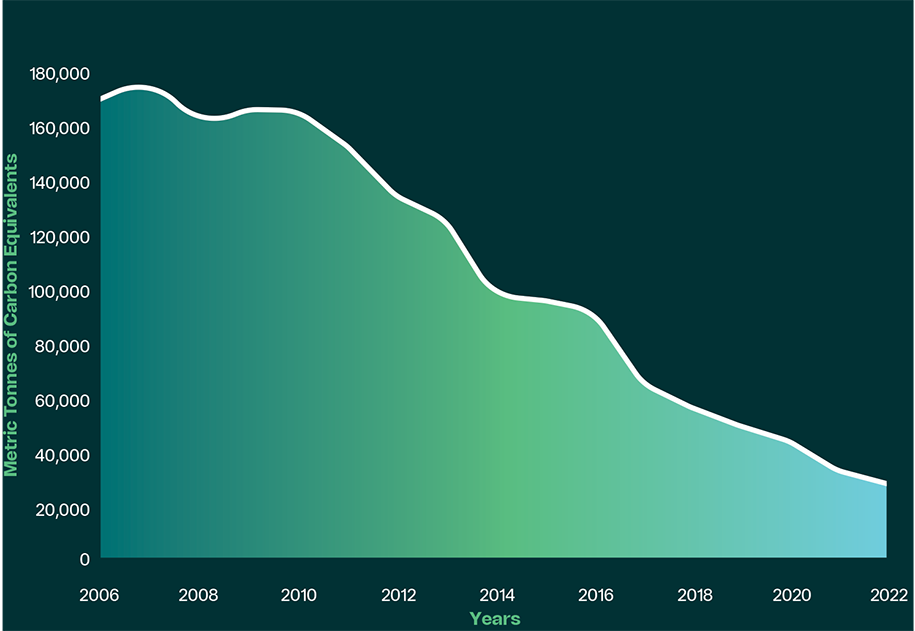
Climate change and carbon emissions
In 2006, we recognized the seriousness of the climate crisis and our potential to engage our associates and other stakeholders in taking meaningful action to become part of the solution.
That year, we set a target to reduce our Scope 1 and Scope 2 GHG emissions by 75% by 2026. We accomplished this goal in 2021, five years ahead of schedule – a testimony to our collaborative spirit and the Unisys leadership team’s embrace of climate action as a business priority.
Countries, companies and people around the world are rallying to reduce the threats posed by climate change. At Unisys, we’re demonstrating our commitment by setting ambitious goals and taking action to shrink our carbon footprint.
Now, we have set a new target: to achieve net zero GHG emissions for Scope 1 and Scope 2 sources by 2030 (the “Net Zero Goal”)1. This builds on our association with other organizations demonstrating climate leadership, like CDP (formerly the Carbon Disclosure Project) and the United Nations Global Compact (UNGC).
1 For purposes of this 2022 Sustainability Report, we define “net zero” as the state achieved when our anthropogenic Scope 1 and Scope 2 GHG emissions to the atmosphere are balanced by anthropogenic removals. Our definition of net zero and our Net Zero Goal are limited to our Scope 1 and Scope 2 GHG emissions sources and do not encompass Scope 3 GHG emissions. Our Net Zero Goal is not validated in connection with the Science Based Targets initiative’s Corporate Net-Zero Standard or classified as a “net zero” target by the Science Based Targets initiative.
Our journey to net zero
In 2022, we developed our near-term target to reduce our combined absolute Scope 1 and Scope 2 GHG emissions by 75% by 2030 from a 2020 base year. This target received validation from SBTi in March 20231.
We see SBTi validation as an important stamp of independent assurance that this near-term target is credible and anchored in sound science and in alignment with the Paris Climate Agreement’s goal of limiting global temperature increase to 1.5°C.
Through 2022, we have already reduced our aggregated Scope 1 and Scope 2 GHG emissions by 37% as compared to our 2020 baseline year2.
While our priority is to reduce our Scope 1 and Scope 2 GHG emissions, we also intend to explore viable options to address residual, harder-to-abate Scope 1 and Scope 2 emissions. These include potential technological developments or tools such as renewable energy credits (to address Scope 2 emissions) as well as carbon credits (to support climate mitigation activities beyond our value chain).
Although our Net Zero Goal is specific to Scope 1 and Scope 2 GHG emissions, we recognize the importance of addressing our Scope 3 emissions and have therefore also set an SBTi-validated target for 78% of our suppliers3 to have their own science-based targets by 2027.
Carbon footprint Scope 1 and Scope 2 GHG emissions

1 SBTi deemed this target to be in conformance with SBTi Criteria and Recommendations (version 4.2). This target was not validated in connection with SBTi’s Corporate Net-Zero Standard or classified as a “net zero” target by SBTi.
2 ISOS Group, Inc. (ISOS) has provided independent assurance of the energy consumption, Scope 1 and Scope 2 GHG emissions, and Scope 2 GHG emissions data in this report. GHG emissions were calculated using the operational control methodology specified in the GHG Protocol. Several smaller Scope 1 GHG emissions sources (e.g., refrigerant releases and mobile combustion sources) were excluded from ISOS’s review.
3 By spend, covering purchased goods, services and capital goods

Leadership’s endorsement of our goal to reach net zero Scope 1 and Scope 2 GHG emissions by 2030 is a new milestone for Unisys. We hit our previous GHG emissions reduction target five years ahead of schedule, and now we’re scaling up our ambition.
Director of Global Environmental, Health, Safety and Security, Unisys
How we’re reducing our emissions
Five actions that enabled us to meet our previous target that will help us take aim at the next one.
1 - Innovating and deploying solutions that reduce our carbon footprint and those of our clients through our products and services
Our Digital Workplace Solutions are designed to optimize remote work; our Cloud Applications & Infrastructure and Enterprise Computing Solutions offer agility and efficiency and unlock innovation.
2 - Optimizing our real estate footprint
In the past four years, our real estate square footage has been reduced globally by about 16%.
3 - Reducing air and vehicle travel
CO2 e emissions from air travel for business in 2022 were 19% lower than in 2019; CO2 e emissions from car travel for business fell 57% in the same period.
4 - Increasing energy efficiency
Since 2019, our power consumption has been reduced globally by about 40%.
5 - Procuring renewable power
In 2022, the purchase of renewable power in the United Kingdom decreased Scope 2 emissions by more than 800 metric tonnes as compared to our 2021 Scope 2 emissions.